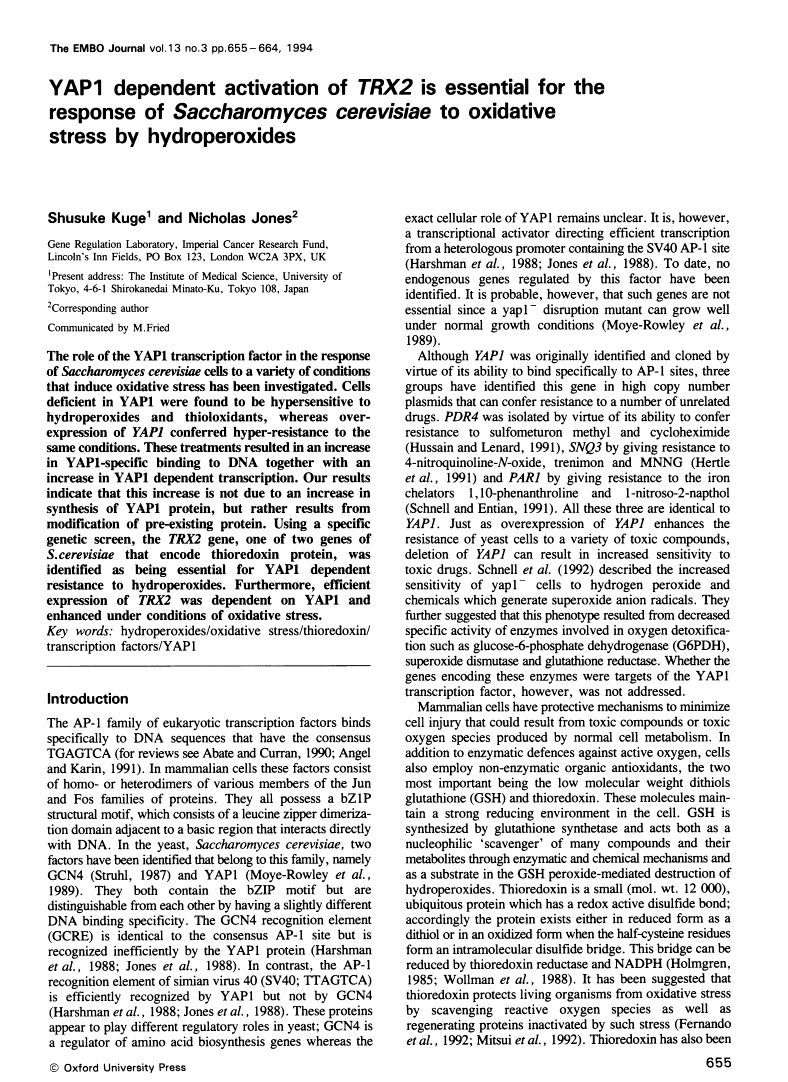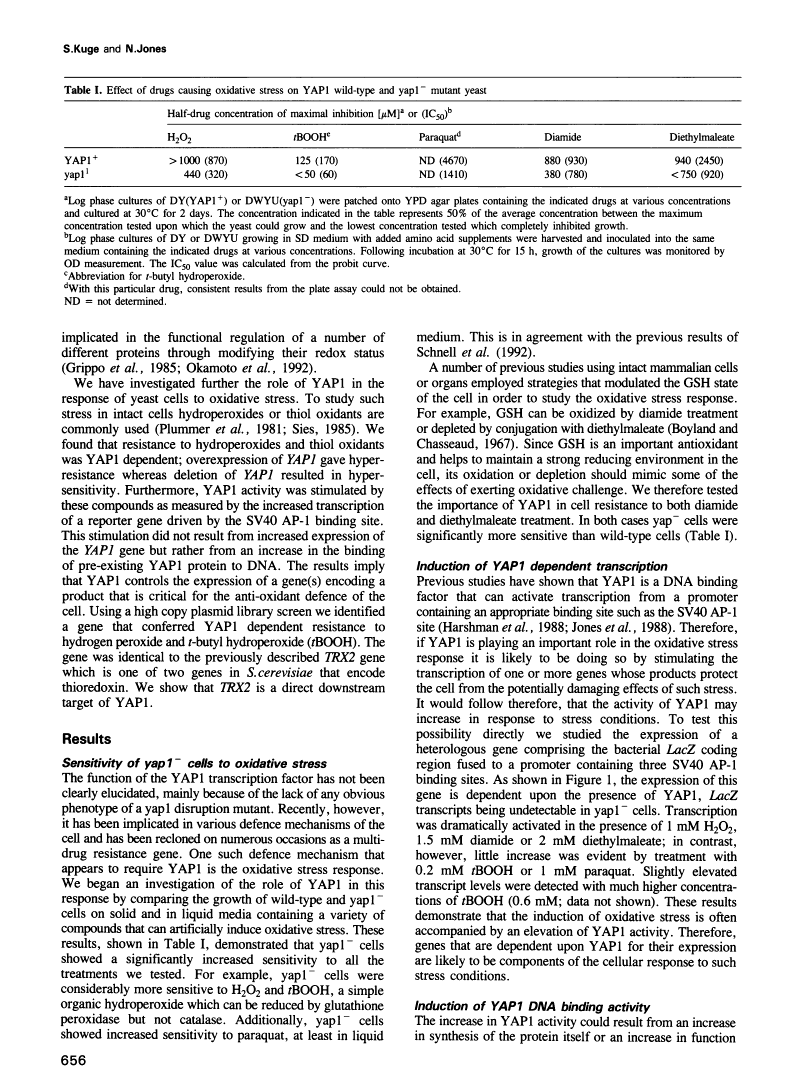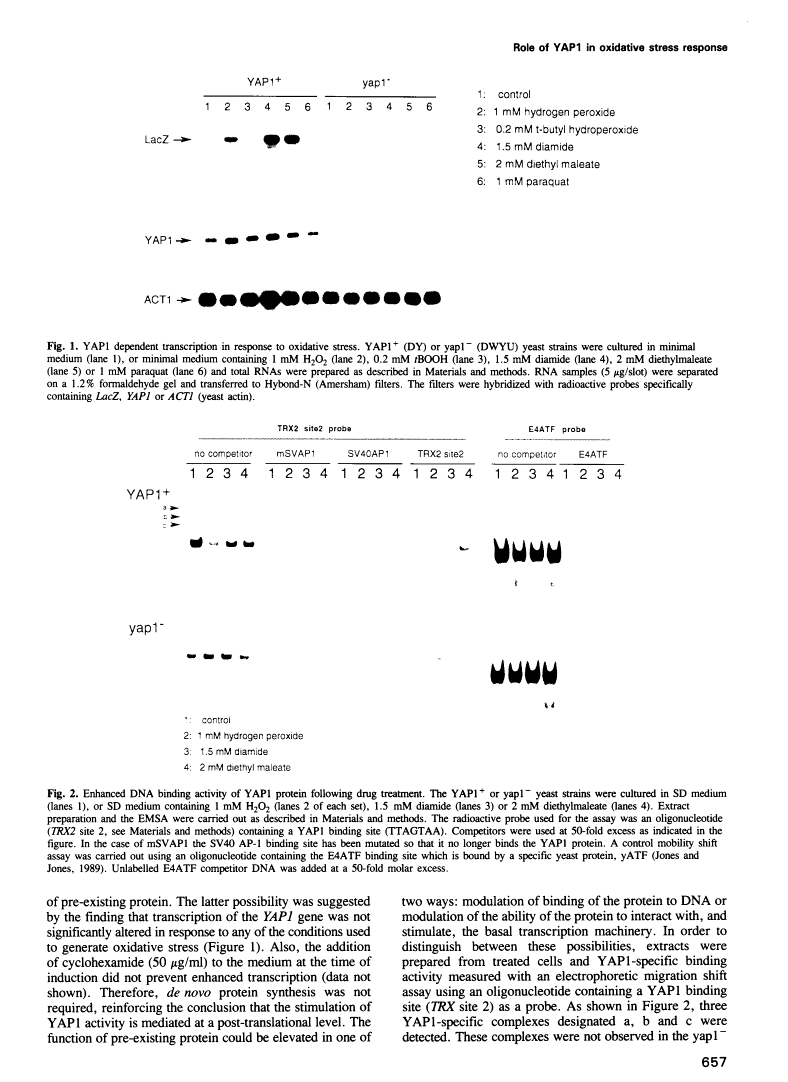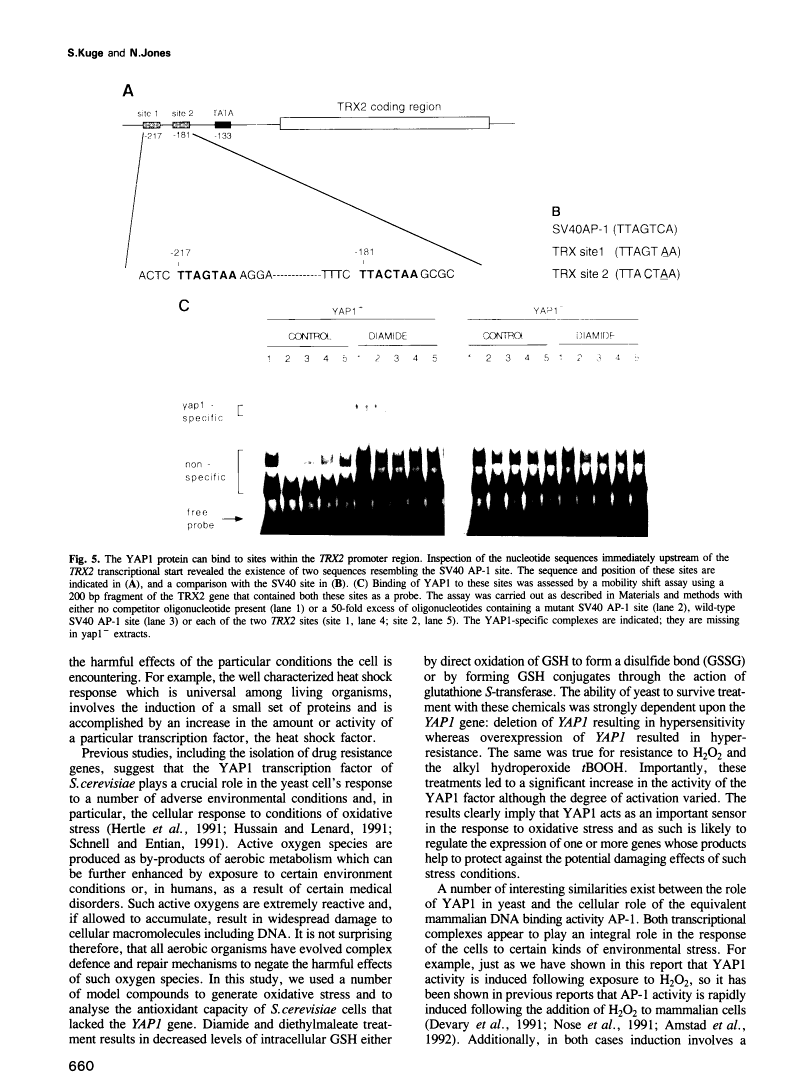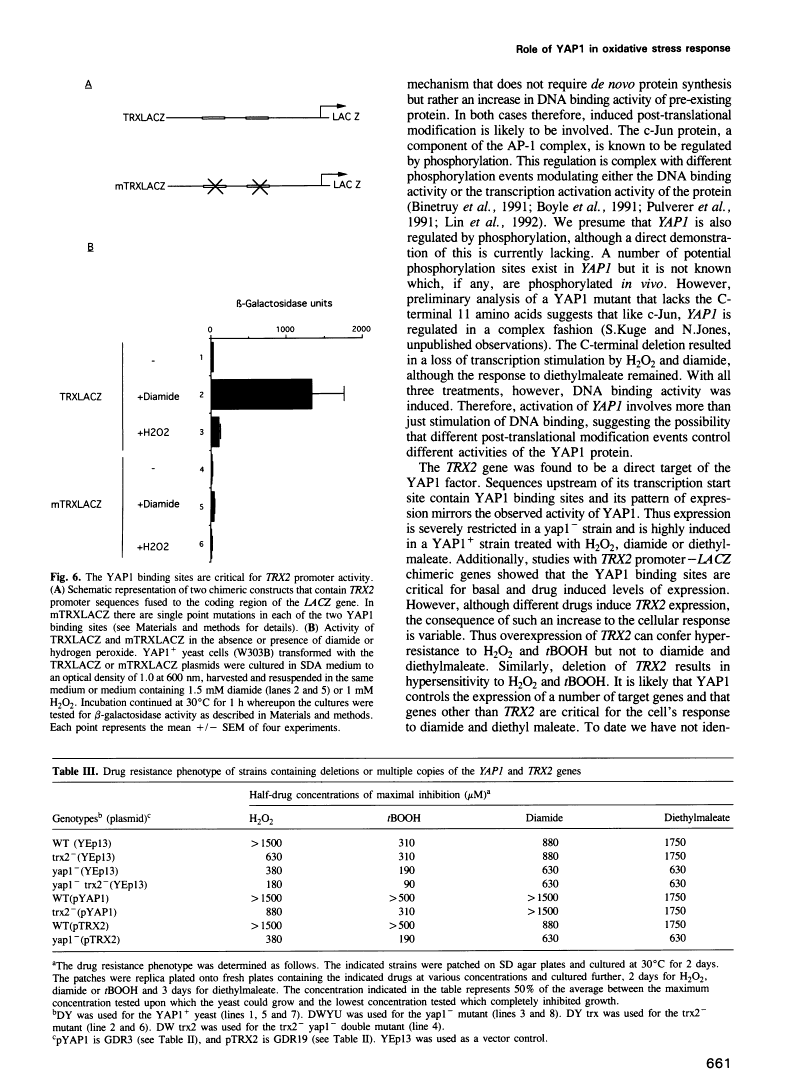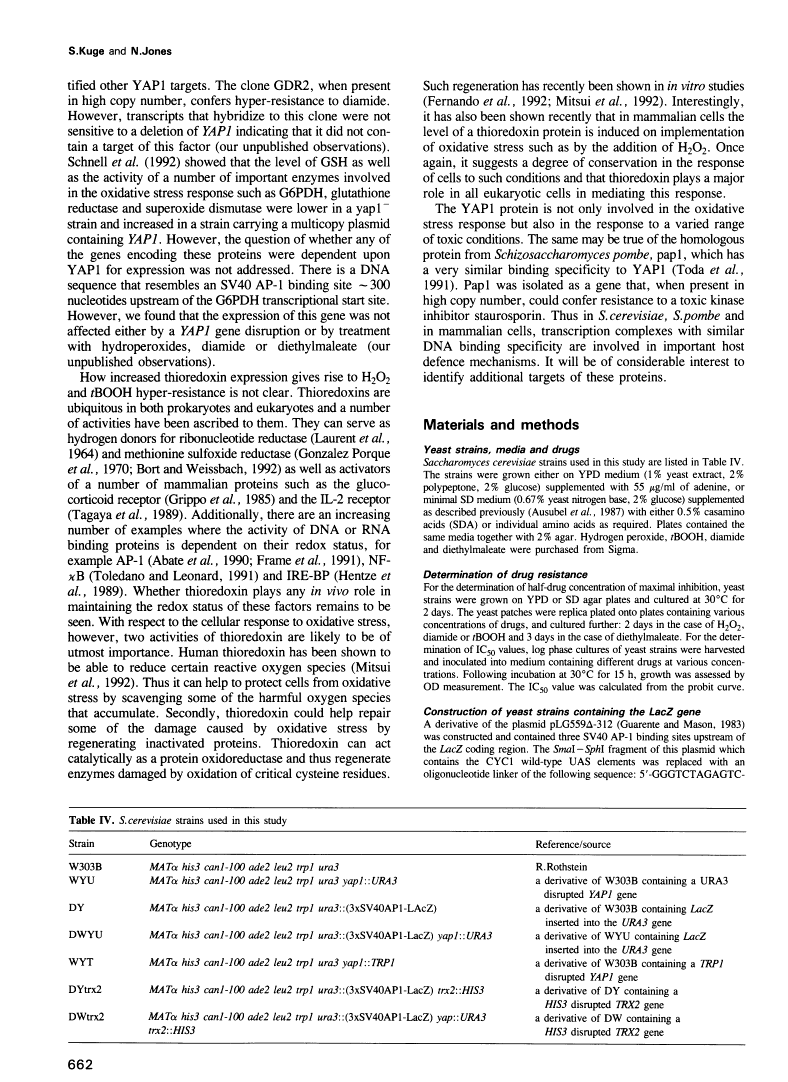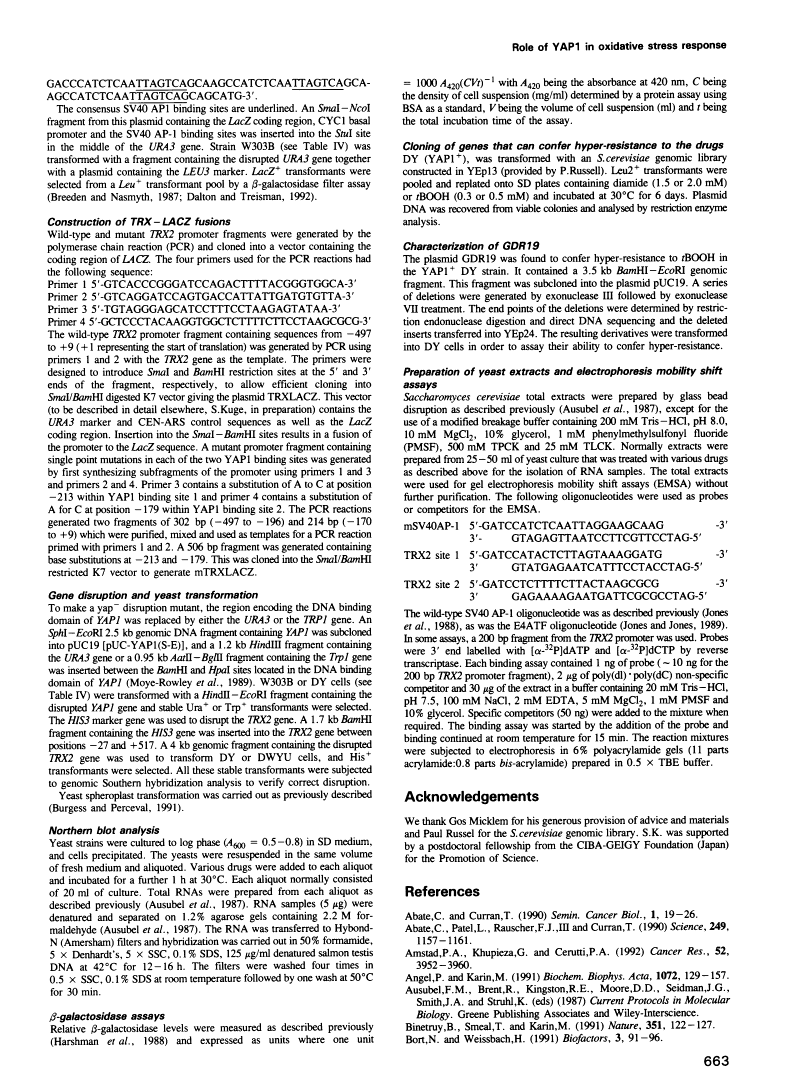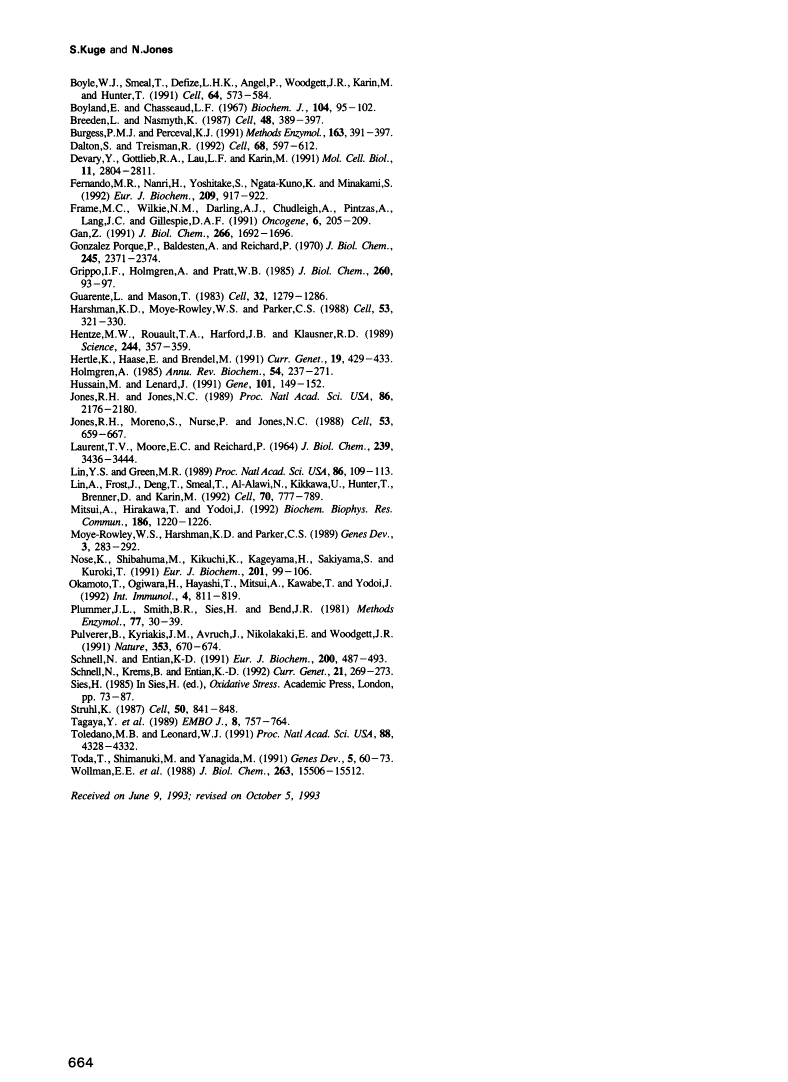Abstract
Free full text

YAP1 dependent activation of TRX2 is essential for the response of Saccharomyces cerevisiae to oxidative stress by hydroperoxides.
Abstract
The role of the YAP1 transcription factor in the response of Saccharomyces cerevisiae cells to a variety of conditions that induce oxidative stress has been investigated. Cells deficient in YAP1 were found to be hypersensitive to hydroperoxides and thioloxidants, whereas overexpression of YAP1 conferred hyper-resistance to the same conditions. These treatments resulted in an increase in YAP1-specific binding to DNA together with an increase in YAP1 dependent transcription. Our results indicate that this increase is not due to an increase in synthesis of YAP1 protein, but rather results from modification of pre-existing protein. Using a specific genetic screen, the TRX2 gene, one of two genes of S. cerevisiae that encode thioredoxin protein, was identified as being essential for YAP1 dependent resistance to hydroperoxides. Furthermore, efficient expression of TRX2 was dependent on YAP1 and enhanced under conditions of oxidative stress.
Full text
Full text is available as a scanned copy of the original print version. Get a printable copy (PDF file) of the complete article (2.1M), or click on a page image below to browse page by page. Links to PubMed are also available for Selected References.
Images in this article
Click on the image to see a larger version.
Selected References
These references are in PubMed. This may not be the complete list of references from this article.
- Abate C, Curran T. Encounters with Fos and Jun on the road to AP-1. Semin Cancer Biol. 1990 Feb;1(1):19–26. [Abstract] [Google Scholar]
- Abate C, Patel L, Rauscher FJ, 3rd, Curran T. Redox regulation of fos and jun DNA-binding activity in vitro. Science. 1990 Sep 7;249(4973):1157–1161. [Abstract] [Google Scholar]
- Amstad PA, Krupitza G, Cerutti PA. Mechanism of c-fos induction by active oxygen. Cancer Res. 1992 Jul 15;52(14):3952–3960. [Abstract] [Google Scholar]
- Angel P, Karin M. The role of Jun, Fos and the AP-1 complex in cell-proliferation and transformation. Biochim Biophys Acta. 1991 Dec 10;1072(2-3):129–157. [Abstract] [Google Scholar]
- Binétruy B, Smeal T, Karin M. Ha-Ras augments c-Jun activity and stimulates phosphorylation of its activation domain. Nature. 1991 May 9;351(6322):122–127. [Abstract] [Google Scholar]
- Brot N, Weissbach H. Biochemistry of methionine sulfoxide residues in proteins. Biofactors. 1991 Jun;3(2):91–96. [Abstract] [Google Scholar]
- Boyle WJ, Smeal T, Defize LH, Angel P, Woodgett JR, Karin M, Hunter T. Activation of protein kinase C decreases phosphorylation of c-Jun at sites that negatively regulate its DNA-binding activity. Cell. 1991 Feb 8;64(3):573–584. [Abstract] [Google Scholar]
- Boyland E, Chasseaud LF. Enzyme-catalysed conjugations of glutathione with unsaturated compounds. Biochem J. 1967 Jul;104(1):95–102. [Europe PMC free article] [Abstract] [Google Scholar]
- Breeden L, Nasmyth K. Cell cycle control of the yeast HO gene: cis- and trans-acting regulators. Cell. 1987 Feb 13;48(3):389–397. [Abstract] [Google Scholar]
- Dalton S, Treisman R. Characterization of SAP-1, a protein recruited by serum response factor to the c-fos serum response element. Cell. 1992 Feb 7;68(3):597–612. [Abstract] [Google Scholar]
- Devary Y, Gottlieb RA, Lau LF, Karin M. Rapid and preferential activation of the c-jun gene during the mammalian UV response. Mol Cell Biol. 1991 May;11(5):2804–2811. [Europe PMC free article] [Abstract] [Google Scholar]
- Fernando MR, Nanri H, Yoshitake S, Nagata-Kuno K, Minakami S. Thioredoxin regenerates proteins inactivated by oxidative stress in endothelial cells. Eur J Biochem. 1992 Nov 1;209(3):917–922. [Abstract] [Google Scholar]
- Frame MC, Wilkie NM, Darling AJ, Chudleigh A, Pintzas A, Lang JC, Gillespie DA. Regulation of AP-1/DNA complex formation in vitro. Oncogene. 1991 Feb;6(2):205–209. [Abstract] [Google Scholar]
- Gan ZR. Yeast thioredoxin genes. J Biol Chem. 1991 Jan 25;266(3):1692–1696. [Abstract] [Google Scholar]
- Gonzalez Porqué P, Baldesten A, Reichard P. The involvement of the thioredoxin system in the reduction of methionine sulfoxide and sulfate. J Biol Chem. 1970 May 10;245(9):2371–2374. [Abstract] [Google Scholar]
- Grippo JF, Holmgren A, Pratt WB. Proof that the endogenous, heat-stable glucocorticoid receptor-activating factor is thioredoxin. J Biol Chem. 1985 Jan 10;260(1):93–97. [Abstract] [Google Scholar]
- Guarente L, Mason T. Heme regulates transcription of the CYC1 gene of S. cerevisiae via an upstream activation site. Cell. 1983 Apr;32(4):1279–1286. [Abstract] [Google Scholar]
- Harshman KD, Moye-Rowley WS, Parker CS. Transcriptional activation by the SV40 AP-1 recognition element in yeast is mediated by a factor similar to AP-1 that is distinct from GCN4. Cell. 1988 Apr 22;53(2):321–330. [Abstract] [Google Scholar]
- Hentze MW, Rouault TA, Harford JB, Klausner RD. Oxidation-reduction and the molecular mechanism of a regulatory RNA-protein interaction. Science. 1989 Apr 21;244(4902):357–359. [Abstract] [Google Scholar]
- Hertle K, Haase E, Brendel M. The SNQ3 gene of Saccharomyces cerevisiae confers hyper-resistance to several functionally unrelated chemicals. Curr Genet. 1991 Jun;19(6):429–433. [Abstract] [Google Scholar]
- Holmgren A. Thioredoxin. Annu Rev Biochem. 1985;54:237–271. [Abstract] [Google Scholar]
- Hussain M, Lenard J. Characterization of PDR4, a Saccharomyces cerevisiae gene that confers pleiotropic drug resistance in high-copy number: identity with YAP1, encoding a transcriptional activator [corrected]. Gene. 1991 May 15;101(1):149–152. [Abstract] [Google Scholar]
- Jones RH, Jones NC. Mammalian cAMP-responsive element can activate transcription in yeast and binds a yeast factor(s) that resembles the mammalian transcription factor ANF. Proc Natl Acad Sci U S A. 1989 Apr;86(7):2176–2180. [Europe PMC free article] [Abstract] [Google Scholar]
- Jones RH, Moreno S, Nurse P, Jones NC. Expression of the SV40 promoter in fission yeast: identification and characterization of an AP-1-like factor. Cell. 1988 May 20;53(4):659–667. [Abstract] [Google Scholar]
- LAURENT TC, MOORE EC, REICHARD P. ENZYMATIC SYNTHESIS OF DEOXYRIBONUCLEOTIDES. IV. ISOLATION AND CHARACTERIZATION OF THIOREDOXIN, THE HYDROGEN DONOR FROM ESCHERICHIA COLI B. J Biol Chem. 1964 Oct;239:3436–3444. [Abstract] [Google Scholar]
- Lin YS, Green MR. Identification and purification of a Saccharomyces cerevisiae protein with the DNA binding specificity of mammalian activating transcription factor. Proc Natl Acad Sci U S A. 1989 Jan;86(1):109–113. [Europe PMC free article] [Abstract] [Google Scholar]
- Lin A, Frost J, Deng T, Smeal T, al-Alawi N, Kikkawa U, Hunter T, Brenner D, Karin M. Casein kinase II is a negative regulator of c-Jun DNA binding and AP-1 activity. Cell. 1992 Sep 4;70(5):777–789. [Abstract] [Google Scholar]
- Mitsui A, Hirakawa T, Yodoi J. Reactive oxygen-reducing and protein-refolding activities of adult T cell leukemia-derived factor/human thioredoxin. Biochem Biophys Res Commun. 1992 Aug 14;186(3):1220–1226. [Abstract] [Google Scholar]
- Moye-Rowley WS, Harshman KD, Parker CS. Yeast YAP1 encodes a novel form of the jun family of transcriptional activator proteins. Genes Dev. 1989 Mar;3(3):283–292. [Abstract] [Google Scholar]
- Nose K, Shibanuma M, Kikuchi K, Kageyama H, Sakiyama S, Kuroki T. Transcriptional activation of early-response genes by hydrogen peroxide in a mouse osteoblastic cell line. Eur J Biochem. 1991 Oct 1;201(1):99–106. [Abstract] [Google Scholar]
- Okamoto T, Ogiwara H, Hayashi T, Mitsui A, Kawabe T, Yodoi J. Human thioredoxin/adult T cell leukemia-derived factor activates the enhancer binding protein of human immunodeficiency virus type 1 by thiol redox control mechanism. Int Immunol. 1992 Jul;4(7):811–819. [Abstract] [Google Scholar]
- Pulverer BJ, Kyriakis JM, Avruch J, Nikolakaki E, Woodgett JR. Phosphorylation of c-jun mediated by MAP kinases. Nature. 1991 Oct 17;353(6345):670–674. [Abstract] [Google Scholar]
- Schnell N, Entian KD. Identification and characterization of a Saccharomyces cerevisiae gene (PAR1) conferring resistance to iron chelators. Eur J Biochem. 1991 Sep 1;200(2):487–493. [Abstract] [Google Scholar]
- Schnell N, Krems B, Entian KD. The PAR1 (YAP1/SNQ3) gene of Saccharomyces cerevisiae, a c-jun homologue, is involved in oxygen metabolism. Curr Genet. 1992 Apr;21(4-5):269–273. [Abstract] [Google Scholar]
- Struhl K. The DNA-binding domains of the jun oncoprotein and the yeast GCN4 transcriptional activator protein are functionally homologous. Cell. 1987 Sep 11;50(6):841–846. [Abstract] [Google Scholar]
- Tagaya Y, Maeda Y, Mitsui A, Kondo N, Matsui H, Hamuro J, Brown N, Arai K, Yokota T, Wakasugi H, et al. ATL-derived factor (ADF), an IL-2 receptor/Tac inducer homologous to thioredoxin; possible involvement of dithiol-reduction in the IL-2 receptor induction. EMBO J. 1989 Mar;8(3):757–764. [Europe PMC free article] [Abstract] [Google Scholar]
- Toledano MB, Leonard WJ. Modulation of transcription factor NF-kappa B binding activity by oxidation-reduction in vitro. Proc Natl Acad Sci U S A. 1991 May 15;88(10):4328–4332. [Europe PMC free article] [Abstract] [Google Scholar]
- Toda T, Shimanuki M, Yanagida M. Fission yeast genes that confer resistance to staurosporine encode an AP-1-like transcription factor and a protein kinase related to the mammalian ERK1/MAP2 and budding yeast FUS3 and KSS1 kinases. Genes Dev. 1991 Jan;5(1):60–73. [Abstract] [Google Scholar]
- Wollman EE, d'Auriol L, Rimsky L, Shaw A, Jacquot JP, Wingfield P, Graber P, Dessarps F, Robin P, Galibert F, et al. Cloning and expression of a cDNA for human thioredoxin. J Biol Chem. 1988 Oct 25;263(30):15506–15512. [Abstract] [Google Scholar]
Associated Data
Articles from The EMBO Journal are provided here courtesy of Nature Publishing Group
Full text links
Read article at publisher's site: https://doi.org/10.1002/j.1460-2075.1994.tb06304.x
Read article for free, from open access legal sources, via Unpaywall:
https://europepmc.org/articles/pmc394856?pdf=render
Citations & impact
Impact metrics
Citations of article over time
Alternative metrics
Smart citations by scite.ai
Explore citation contexts and check if this article has been
supported or disputed.
https://scite.ai/reports/10.1002/j.1460-2075.1994.tb06304.x
Article citations
An evolutionarily conserved phosphoserine-arginine salt bridge in the interface between ribosomal proteins uS4 and uS5 regulates translational accuracy in Saccharomyces cerevisiae.
Nucleic Acids Res, 52(7):3989-4001, 01 Apr 2024
Cited by: 0 articles | PMID: 38340338 | PMCID: PMC11040005
Mechanism of furfural toxicity and metabolic strategies to engineer tolerance in microbial strains.
Microb Cell Fact, 22(1):221, 28 Oct 2023
Cited by: 2 articles | PMID: 37891678 | PMCID: PMC10612203
Review Free full text in Europe PMC
A novel zinc finger transcription factor, BcMsn2, is involved in growth, development, and virulence in Botrytis cinerea.
Front Microbiol, 14:1247072, 17 Oct 2023
Cited by: 1 article | PMID: 37915851 | PMCID: PMC10616473
PeAP1-mediated oxidative stress response plays an important role in the growth and pathogenicity of Penicillium expansum.
Microbiol Spectr, e0380822, 21 Sep 2023
Cited by: 1 article | PMID: 37732795 | PMCID: PMC10581040
Yap1-mediated Flr1 expression reveals crosstalk between oxidative stress signaling and caffeine resistance in Saccharomyces cerevisiae.
Front Microbiol, 13:1026780, 23 Nov 2022
Cited by: 1 article | PMID: 36504777 | PMCID: PMC9726721
Go to all (266) article citations
Data
Similar Articles
To arrive at the top five similar articles we use a word-weighted algorithm to compare words from the Title and Abstract of each citation.
The role of the YAP1 and YAP2 genes in the regulation of the adaptive oxidative stress responses of Saccharomyces cerevisiae.
Mol Microbiol, 16(3):415-423, 01 May 1995
Cited by: 117 articles | PMID: 7565103
The Skn7 response regulator controls gene expression in the oxidative stress response of the budding yeast Saccharomyces cerevisiae.
EMBO J, 16(5):1035-1044, 01 Mar 1997
Cited by: 183 articles | PMID: 9118942 | PMCID: PMC1169703
Role of thioredoxins in the response of Saccharomyces cerevisiae to oxidative stress induced by hydroperoxides.
Mol Microbiol, 43(4):993-1003, 01 Feb 2002
Cited by: 89 articles | PMID: 11929546
How to flip the (redox) switch.
Cell, 111(5):607-610, 01 Nov 2002
Cited by: 93 articles | PMID: 12464172
Review
